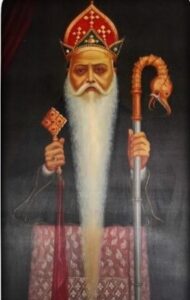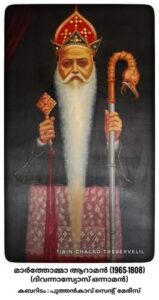Mar Thoma VI – Mar Dionysius I – April 8 I Mar Dionysius the Great (Valiya Mar Dionysius)
Mar Dionysius I, was the sixth Metropolitan of the Malankara Church from 1765 until his death, in 1808. He belonged to the Pakalomattom family (Thazhmon, Ayroor). Thus, was also known as Mar Thoma VI. Mar Thoma VI is the first of the fathers to adopt an Antiochian name (Dionysius) after his ordination by an Antiochian bishop. He was the nephew of his predecessor as Malankara Metropolitan, Mar Thoma V, Upon Mar Thoma V’s death in 1765, the younger Pakalomattom was ordained as Metropolitan on 8 May, taking the name Mar Thoma VI, at the hands of the Orthodox Syrian bishop Mar Gregorios in the Church in Niranam.

Mar Thoma VI succeeded Mar Thoma V as Malankara Metropolitan in 1765, and unlike his predecessors, who were claimed by their opponents not to have been properly ordained as bishop, he received orders from Orthodox Syrian bishops, Mar Gregorios Yuhanon (Metropolitan of Jerusalem) and Mar Ivanios thus ending any controversy and was known Valiya Mar Dionysius. The first Malankara Metropolitan, to obtain the title Mar Dionysius. He was the greatest and most influential of all the bishops of the Pakalomattom family, and is therefore usually called Mar Dionysius the Great.

Mar Dionysius I was a man of rare abilities and attainments. He was a shrewd administrator who appealed to outside authorities to assert his position as the sole leader of the Malankara Church and to attempt to reunite all the Saint Thomas Christians. It was during his reign the separation of the Thozhiyoor church (now the Malabar Independent Syrian Church), the arrival of English Protestant missionaries, and the first translation of the Bible from Syriac to Malayalam. During his lifetime he tried to unite the St. Thomas Christians of Kerala who had accepted Catholic faith under his leadership. He also was persecuted for his stance on Church unity and even imprisoned.
He was also instrumental in starting Trust Fund deposit, as an additional income as a fixed deposit, the interest was to be used, to train of priests. However, it was Mar Thoma VII, who deposited the amount to the government, which was known as Vattipanam.
Dr. Claudius Buchanan, who visited him in his old age, describes him thus: “He is a man of highly respectable character in his Church, eminent for his piety and for the attention he devotes to his sacred functions. I found him to be far superior in general learning to any of his clergy whom I had yet seen.” During the Mar Dionysius’ time, the States of Travancore and of Mysore, and the Syrian Christians underwent lot of suffering and persecution caused by the invasion of the then king of Mysore, Tippu Sultan.

He had long, glorious and effective reign, interspersed by persecutions and invasions, Mar Dionysius, I passed away on 8 April 1808 at Niranam, and he was interred at the altar of St. Mary’s Orthodox Cathedral, Puthencavu, a place selected by him before his passing away. The Church, was built and endowed at his own expense.

0 Comments